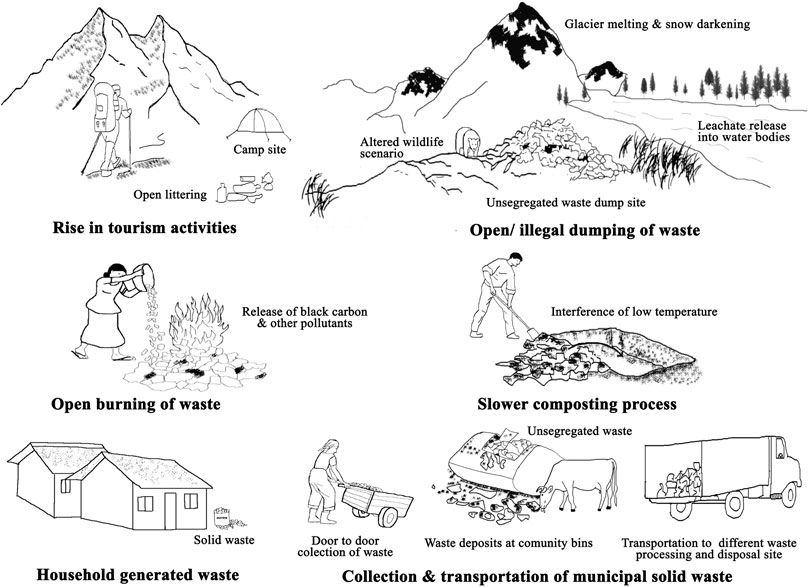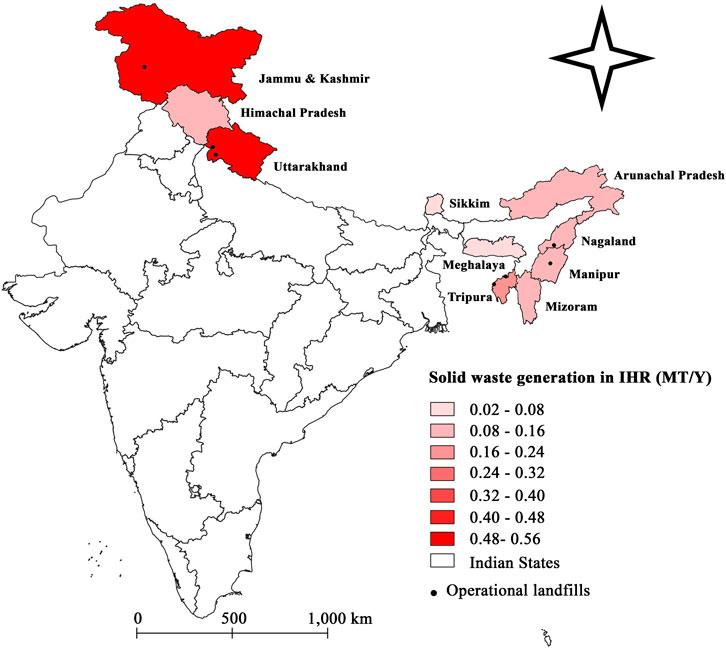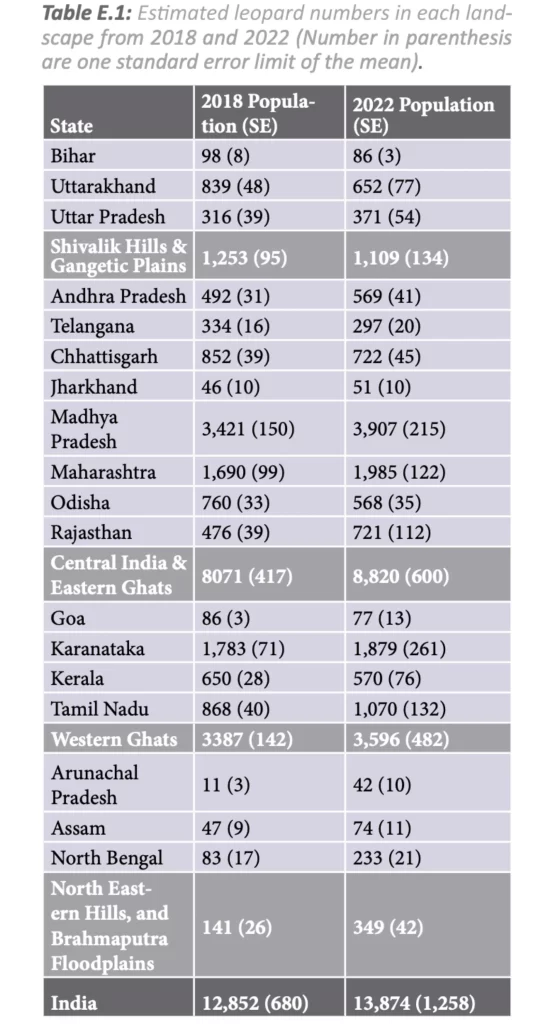CONTENTS
- Mountains of Plastic are Choking the Himalayan States
- Surge in the Indian Leopard Population Despite Challenges
Mountains of Plastic are Choking The Himalayan States
Context:
Plastic is omnipresent, spanning from the highest mountain peaks to the deepest ocean trenches, and it is even present inside human lungs and placenta. The Indian Himalayan Region, a crucial water source for the subcontinent, nourishes major rivers like the Indus, Ganges, and Brahmaputra. Inadequate and unscientific plastic disposal practices are causing soil and water pollution in this region, adversely affecting biodiversity and posing a threat to the freshwater sources vital for downstream communities.
Relevance:
GS1-
- Geographical Features and their Location
- Physical Geography
GS3- Environmental Pollution and Degradation
Mains Question:
Examine the menace of plastic waste in the Indian Himalayan Region. How can empowering local bodies and creating the necessary infrastructure for waste management offer solutions to this problem? (15 Marks, 250 Words).
Plastic Waste Crisis in the Himalayas:
- The Himalayan mountains, rivers, lakes, and streams exhibit the deposition and accumulation of microplastics. Glaciers can entrap microplastics for extended periods, releasing them into rivers during snowmelt.
- The plastic waste crisis in the Indian Himalayan Region is primarily attributed to rapid and unplanned urbanization, along with shifts in production and consumption patterns. The escalating number of tourists further compounds the issue.
- The waste audit results reveal that 92.7% of the trash consisted of plastic, with 72% of the waste being non-recyclable plastic in the Indian Himalayan Region.
- The recent report from the Social Development for Communities (SDC) Foundation in Dehradun, highlighting the overwhelming presence of plastic waste in Uttarakhand towns, aligns with the challenges faced by nearly all mountainous states.
- Notably, the National Green Tribunal has issued notices to various authorities, including the Ministry of Environment, Forest and Climate Change, the Central Pollution Control Board (CPCB), and regional bodies, addressing waste dumping in eco-sensitive areas by both tourists and commercial establishments.

Plastic Waste in Other Areas:
- Instances of plastic waste impacting wildlife are observed across the country. In Assam’s Ramsar site of Deepor Beel, Greater adjutant storks are seen consuming plastic waste instead of the usual fish from the wetland.
- Manipur reports growing pollution in rivers like the Nambul. The Himalayan Clean up initiative, conducted between 2018 and 2021 by the Integrated Mountain Initiative in collaboration with Zero Waste Himalayas and the National Productivity Council of India, along with the more recent Himalayan Clean up of 2022, illustrates a concerning trend.

Why Does this Amount to an Alarming Situation?
- Plastic Overshoot Day marks the annual occurrence when the volume of plastic waste exceeds the capacity of waste management systems to handle it. According to Environment Action, a Swiss-based organization, India experienced its Plastic Overshoot Day on January 6, 2023, which is particularly alarming.
- India possesses one of the highest Mismanaged Waste Index (MWI) figures globally, standing at 98.55%, trailing behind only Kenya, Nigeria, and Mozambique. This index reflects the disparity between waste management capacity and plastic consumption.
- Despite the Government of India asserting a 60% plastic waste recycling rate, a statistical analysis conducted by the Centre for Science and Environment (CSE) using CPCB data reveals that only 12% of plastic waste is actually recycled through mechanical means.
- Approximately 20% of the plastic waste undergoes end-of-life solutions, including co-incineration, plastic-to-fuel, and road construction. However, this implies that around 20% of plastic waste is incinerated while still being classified as ‘recycling.’
- Moreover, a substantial 68% of plastic waste remains unaccounted for, emphasizing the significant challenge in effectively managing and curbing plastic pollution in the country.
Regulatory Framework for Plastic Waste Management in India and Their Analysis:
| Legislations by the Union Government: Solid Waste Management Rules (SWM) of 2016, Plastic Waste Management (PWM) Rules of 2016, and the Extended Producer Responsibility (EPR) guidelines introduced in 2022: The combined mandate of SWM/PWM/EPR emphasizes waste segregation at the source. This involves not only segregating plastic from other waste but also categorizing different types of plastics—an essential aspect for a scientifically and sustainably managed disposal of plastic waste. According to the Solid Waste Management (SWM), Plastic Waste Management (PWM), and Extended Producer Responsibility (EPR) frameworks, the responsibility for waste management, encompassing collection to its scientific disposal, lies with local bodies. These bodies have the option to seek assistance from Producers, Importers, and Brand Owners (PIBOs) for establishing and operating the plastic waste management system, as stipulated by the EPR. | While the SWM acknowledges the specific needs of hill areas, these considerations are not effectively integrated into mandates for local bodies and producers, importers, and brand owners (PIBOs). Moreover, the PWM and EPR fail to recognize the distinct requirements of hilly terrains. While waste segregation is theoretically endorsed, on closer inspection, landfills are observed to be overflowing with mixed waste. Leachate from such mixed waste contributes to soil and groundwater pollution, while emissions from the waste cause air pollution. A substantial quantity of recyclable plastic waste remains deposited in landfills, highlighting a significant gap between policy intentions and practical implementation. While local bodies are central to the waste management system nationwide, there is an ongoing effort to appropriately devolve power to them. Currently, only a few states have enacted model by-laws, and a limited number of local bodies have formulated by-laws to operationalize this mandate. The collaboration between local bodies and PIBOs lacks clarity in terms of its specific mandate. |
| State Legislations: Himachal Pradesh and Sikkim have implemented state laws prohibiting the use of plastics, with Himachal Pradesh adopting a buy-back policy for non-recyclable and single-use plastic waste since 2019. Mizoram has been proactive in establishing regulations, with the Aizawl Municipal Corporation formulating by-laws under the PWM in 2019. Tripura has implemented policy changes, municipal by-laws, and a state-level task force targeting the elimination of Single-Use Plastic. | However, despite such policies, there is still widespread littering of plastic waste. Sikkim, which banned the use of packaged mineral water from January 2022, has a robust regulatory system but grapples with the issue due to inadequate infrastructure for plastic waste management. Similarly, although legislative framework exists in Tripura, the outcomes are not yet apparent. |
Way Forward:
- It is essential to broaden the definition of local bodies in the context of the Indian Himalayan Region, where traditional institutions play a significant role, particularly in several states in the northeast.
- It’s noteworthy that traditional institutions were allocated funds under the Swachh Bharat Mission (SBM) and the Fifteenth Finance Commission. This inclusion emphasizes the need to recognize and involve traditional institutions in waste management efforts.
- Addressing data gaps is an initial step in the right direction. Resource allocation and support must be tailored to the unique biodiversity, ecological sensitivity, and fragility of the Indian Himalayan Region.
- This approach should also consider the specific challenges posed by the geography of mountain waste management. Immediate attention is required to empower local bodies and establish essential infrastructure for effective waste management.
- Waste segregation and public participation, facilitated by sustained education campaigns, are crucial components of this effort.
- To counter the geographical neutrality of targets outlined in the Extended Producer Responsibility (EPR), due consideration should be given to the higher operational cost of EPR in mountainous regions.
- The EPR certificate’s value, earned by Producers, Importers, and Brand Owners (PIBOs) in the Indian Himalayan Region, could surpass that earned in other parts of the country for every ton of processed plastic waste.
- It is imperative to fill data gaps regarding the quantity and quality of waste generated in the states of the Indian Himalayan Region.
- The Swachh Bharat Kosh Trust, designed to facilitate the channeling of philanthropic contributions and corporate social responsibility funds, could also be utilized to enhance resources.
Conclusion:
There is a need for convergence of existing schemes, such as the Swachh Bharat Mission (SBM), the Mahatma Gandhi National Rural Employment Guarantee Act, Atal Mission for Rejuvenation, Urban Transformation (AMRUT) and the Smart Cities Scheme and the grants from the Finance Commission, can be leveraged to create, maintain, and operate necessary waste management infrastructure.
Surge in the Indian Leopard Population Despite Challenges
Context:
In the face of escalating environmental and human-animal conflict issues, the leopard population in India has witnessed an increase, reaching an impressive total of 13,874. This growth highlights the resilience of these magnificent creatures and signifies the success of conservation endeavors in our nation.
Relevance:
GS3- Environment-
- Biodiversity
- Conservation
Mains Question:
In the context of the recently released ‘Status of Leopards in India, 2022’ Report, discuss the concerns faced by the Indian Leopard. What factors have led to a surge in numbers despite these challenges? (10 Marks, 150 Words).
About the Indian Leopard:
Scientific Name: Panthera pardus
Overview:
- Leopards, characterized by their elusive and nocturnal nature, exhibit variations in size and color influenced by their habitat.
- Known for their adept climbing skills, they often seek refuge in trees to conceal their prey and avoid competition.
Geographical Distribution:
- Belonging to the cat family, leopards inhabit a diverse range of regions, including Asia, sub-Saharan Africa, Southern Russia, and the Indian subcontinent.
- The Indian leopard, scientifically identified as Panthera pardus fusca, is prominently found across the Indian subcontinent.
Habitat:
Leopards showcase notable adaptability in terms of their habitat preferences and dietary needs. They are commonly spotted in agro-pastoral landscapes, plantations, and in close proximity to human settlements, encompassing both rural and urban areas.
Conservation Status:
- Leopards are classified as ‘Vulnerable’ on the IUCN Red List and are listed under Appendix I of CITES.
- The Wildlife Protection Act of 1972 designates them under Schedule I, acknowledging their need for stringent protection measures.

Population in India:
- According to the ‘Status of Leopards in India, 2018’ report released by the Ministry of Environment, Forest and Climate Change (MoEF&CC), there was a remarkable “60% increase in the population count of leopards in India compared to the 2014 estimates.”
- The ‘Status of Leopards in India, 2022’ report, published by the Union Environment Ministry on February 29, reveals an approximate leopard count of 13,874 in India, marking an increase from the 2018 figure of 12,852.
Associated Concerns:
Man-Animal Conflict:
Leopards in India inhabit a variety of landscapes, ranging from dense forests to urban areas. However, their proximity to human settlements often results in conflicts, as leopards enter villages in search of food or territory, leading to attacks on livestock and occasionally on humans. Such encounters pose significant threats to both leopard populations and human communities.
Poaching:
Moreover, poaching remains a profitable enterprise, with influential individuals anonymously employing locals; it is crucial to identify and hold them accountable.
Climate Change and other Issues:
Climate change exacerbates these challenges by modifying natural habitats and prey availability. Additionally, forest fragmentation, biodiversity loss, and other changes contribute to the stress on leopard populations.
‘Status of Leopards in India, 2022’-
- The Union Minister for Environment, Forest and Climate Change released the Status of Leopards in India report, providing valuable insights into leopard population dynamics and conservation status across the country.
- The fifth cycle of leopard population estimation focused on forested habitats within 18 tiger states, covering significant tiger conservation landscapes, excluding non-forested habitats and the high Himalayas from the sampling.
- The survey included a foot survey spanning 6,41,449 km and strategically placed camera traps at 32,803 locations, resulting in 4,70,81,881 photographs.
Key Findings of the Report:
Leopard Population Estimate: The report indicates an estimated leopard population of 13,874 individuals in India, reflecting a stable population compared to the 2018 estimate of 12,852 individuals. The survey covered 70% of the leopard habitat, excluding areas like the Himalayas and semi-arid regions not considered part of tiger habitats.
Regional Variations: Central India demonstrates a stable or slightly growing leopard population, whereas the Shivalik hills and Gangetic plains experienced a decline. In areas sampled both in 2018 and 2022 across India, there is a 1.08% per annum growth. The Shivalik hills and Gangetic plains exhibit a 3.4% decline per annum, with the largest growth rate observed in Central India and Eastern Ghats at 1.5%.

State-wise Distribution: Madhya Pradesh has the largest leopard population (3907), followed by Maharashtra, Karnataka, and Tamil Nadu. Tiger reserves or locations with the highest leopard populations include Nagarajunasagar Srisailam (Andhra Pradesh), Panna (Madhya Pradesh), and Satpura (Madhya Pradesh).
Conservation Challenges: The report emphasizes the pivotal role of Protected Areas in conserving leopard populations. While tiger reserves play a crucial role, addressing conservation gaps outside protected areas is equally vital. Escalating incidents of human-wildlife conflict pose challenges, emphasizing the necessity for collaborative efforts involving government agencies, conservation organizations, and local communities.
Factors Behind the Rise in Numbers:
- Despite these adversities, the increase in India’s leopard population can be attributed to various factors, including conservation initiatives and the enforcement of stricter wildlife protection laws.
- Both governmental and non-governmental entities have been actively engaged in preserving habitats, anti-poaching endeavors, and fostering awareness within local communities regarding leopard conservation.
- Employing advanced techniques such as camera trapping and satellite tracking has provided crucial insights into leopard behavior, habitat utilization, and population dynamics, thereby enhancing the effectiveness of conservation strategies.
- Notably, community-based conservation approaches have yielded promising outcomes, emphasizing the importance of involving local communities in conservation initiatives, which instills a sense of ownership and responsibility.
Way Forward:
- To sustain the upward trajectory of leopard populations, concerted efforts from the Government are imperative. While the increase in leopard numbers is encouraging, it must not come at the expense of human lives.
- Launching awareness campaigns in leopard-inhabited areas is crucial, focusing on educating communities about leopard behavior, conservation significance, and strategies to prevent conflicts.
- Implementing low-cost, innovative measures, such as wearing masks at the back of heads in places like Sundarbans to deter Royal Bengal Tigers, can be explored to safeguard human lives.
- Additionally, reinforcing habitat conservation endeavors is paramount, encompassing initiatives like reforestation, the establishment of wildlife corridors, and curtailing human encroachment into natural habitats.
- Dismissing misconceptions about rural communities being hostile towards animals is essential, recognizing their historical coexistence with wildlife.
- Stringent enforcement of wildlife protection laws by law enforcement agencies is crucial to combat poaching, illegal wildlife trade, and habitat destruction.
- Collaboration with international organizations and neighboring countries is necessary to address transboundary conservation issues effectively.
- There is a pressing need for a new wildlife policy that considers the current circumstances and strikes a balance between human and animal interests.
Conclusion:
This holistic approach, integrating community involvement, technological advancements, habitat preservation, and international collaboration, will contribute to the sustained conservation and coexistence of leopards and humans.





